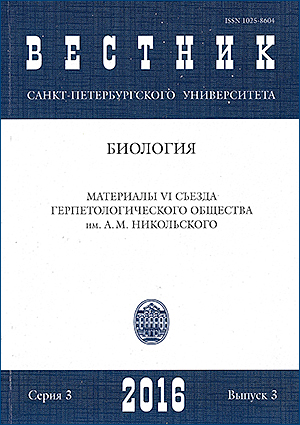Geographic variation in the characteristics of Rana temporaria metamorphs
DOI:
https://doi.org/10.21638/11701/spbu03.2016.315Abstract
Geographical differences and the structure of intrapopulation phenotypic variation in metamorphs’ life-history traits from 6 spatially distant populations of Rana temporaria were studied. In frogs from northern populations, heritability of larval period duration, growth rate, and size at metamorphosis was relatively low. Growth rate and size at metamorphosis in laboratory frogs were significantly higher than in those collected in nature, whereas the larval period, in turn, was lower. The revealed differences within and between populations represent a counter-gradient variation. The genetic and phenotypic correlations by pairwise comparisons these three traits were similar (both in magnitude and sign) in all populations, with the exception of one population from Kamchatka. This population was successfully introduced 10 years ago from the Moscow region to the habitat with the minimal duration of activity season. The genetic correlation between body size at metamorphosis and larval period was significantly negative. Thus the response to shortening of activity season was not only the growth rate increase but decrease in larval period, partially at the expense of metamorph size. Refs 6. Tables 2.
Keywords:
geographical variation, heritability, growth rate, metamorphosis, Rana temporaria
Downloads
References
Downloads
Published
How to Cite
Issue
Section
License
Articles of Biological Communications are open access distributed under the terms of the License Agreement with Saint Petersburg State University, which permits to the authors unrestricted distribution and self-archiving free of charge.





